Astronomers discover first population of binary stripped stars
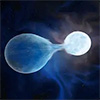 New findings confirm existence of hot helium stars long-thought to be at the heart of hydrogen-poor supernovae and neutron star mergers.
New findings confirm existence of hot helium stars long-thought to be at the heart of hydrogen-poor supernovae and neutron star mergers.
Dec 15th, 2023
Read more
 Subscribe to our Space Exploration News feed
Subscribe to our Space Exploration News feed
 New findings confirm existence of hot helium stars long-thought to be at the heart of hydrogen-poor supernovae and neutron star mergers.
New findings confirm existence of hot helium stars long-thought to be at the heart of hydrogen-poor supernovae and neutron star mergers.
Dec 15th, 2023
Read more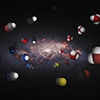 Using powerful telescopes to split two galaxies' light into individual colors, scientists were amazed to discover light from many different molecules - more than ever before at such distances.
Using powerful telescopes to split two galaxies' light into individual colors, scientists were amazed to discover light from many different molecules - more than ever before at such distances.
Dec 14th, 2023
Read more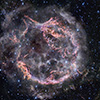 Like a shiny, round ornament ready to be placed in the perfect spot on a holiday tree, supernova remnant Cassiopeia A (Cas A) gleams in a new image from the James Webb Space Telescope.
Like a shiny, round ornament ready to be placed in the perfect spot on a holiday tree, supernova remnant Cassiopeia A (Cas A) gleams in a new image from the James Webb Space Telescope.
Dec 12th, 2023
Read more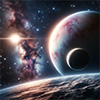 The extrasolar planets Kepler-1625b and Kepler-1708b are supposedly the home worlds of the first known exomoons. A new study now comes to a different conclusion.
The extrasolar planets Kepler-1625b and Kepler-1708b are supposedly the home worlds of the first known exomoons. A new study now comes to a different conclusion.
Dec 8th, 2023
Read more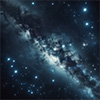 How heavy can an element be? Scientists have found that ancient stars were capable of producing elements with atomic masses greater than 260, heavier than any element on the periodic table found naturally on Earth. The finding deepens our understanding of element formation in stars.
How heavy can an element be? Scientists have found that ancient stars were capable of producing elements with atomic masses greater than 260, heavier than any element on the periodic table found naturally on Earth. The finding deepens our understanding of element formation in stars.
Dec 8th, 2023
Read more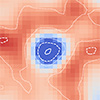 Galactic winds, observed in galaxies over 7 billion years old, play a crucial role in regulating their growth and star formation rate by facilitating matter exchange with their surroundings.
Galactic winds, observed in galaxies over 7 billion years old, play a crucial role in regulating their growth and star formation rate by facilitating matter exchange with their surroundings.
Dec 7th, 2023
Read more Colliding pieces of space debris emit electric signals that could help track small debris littering Earth's orbit, potentially saving satellites and spacecraft.
Colliding pieces of space debris emit electric signals that could help track small debris littering Earth's orbit, potentially saving satellites and spacecraft.
Dec 5th, 2023
Read more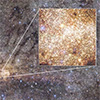 Through analysis of high-resolution data from a ten-metre telescope, researchers have succeeded in generating new knowledge about three stars at the very heart of the Milky Way. The stars proved to be unusually young with a puzzling chemical composition that surprised the researchers.
Through analysis of high-resolution data from a ten-metre telescope, researchers have succeeded in generating new knowledge about three stars at the very heart of the Milky Way. The stars proved to be unusually young with a puzzling chemical composition that surprised the researchers.
Dec 5th, 2023
Read more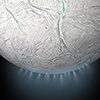 Researchers have demonstrated that amino acids within Enceladus' ice plumes can endure impact speeds up to 4.2 km/s, bolstering their detection in spacecraft sampling and supporting Enceladus as a key target in the search for extraterrestrial life.
Researchers have demonstrated that amino acids within Enceladus' ice plumes can endure impact speeds up to 4.2 km/s, bolstering their detection in spacecraft sampling and supporting Enceladus as a key target in the search for extraterrestrial life.
Dec 5th, 2023
Read more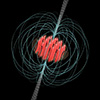 A collaboration between quantum physicists and astrophysicists has achieved a significant breakthrough in understanding neutron star glitches. They were able to numerically simulate this enigmatic cosmic phenomenon with ultracold dipolar atoms.
A collaboration between quantum physicists and astrophysicists has achieved a significant breakthrough in understanding neutron star glitches. They were able to numerically simulate this enigmatic cosmic phenomenon with ultracold dipolar atoms.
Dec 5th, 2023
Read more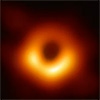 An entirely new way to probe how active black holes behave when they eat has been discovered by an international team of astronomers.
An entirely new way to probe how active black holes behave when they eat has been discovered by an international team of astronomers.
Dec 5th, 2023
Read more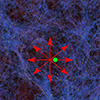 Study proposes a solution to one of the great mysteries of cosmology.
Study proposes a solution to one of the great mysteries of cosmology.
Dec 2nd, 2023
Read more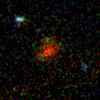 It first appeared as a glowing blob from ground-based telescopes and then vanished completely in images from the Hubble Space Telescope. Now, the ghostly object has reappeared as a faint, yet distinct galaxy in an image from the James Webb Space Telescope.
It first appeared as a glowing blob from ground-based telescopes and then vanished completely in images from the Hubble Space Telescope. Now, the ghostly object has reappeared as a faint, yet distinct galaxy in an image from the James Webb Space Telescope.
Dec 2nd, 2023
Read more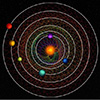 Scientists have discovered a rare sight in a nearby star system: Six planets orbiting their central star in a rhythmic beat. The planets move in an orbital waltz that repeats itself so precisely it can be readily set to music.
Scientists have discovered a rare sight in a nearby star system: Six planets orbiting their central star in a rhythmic beat. The planets move in an orbital waltz that repeats itself so precisely it can be readily set to music.
Nov 29th, 2023
Read more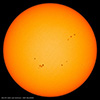 Scientists have discovered a new relationship between the Sun's magnetic field and its sunspot cycle, that can help predict when the peak in solar activity will occur. Their work indicates that the maximum intensity of solar cycle 25, the ongoing sunspot cycle, is imminent and likely to occur within a year.
Scientists have discovered a new relationship between the Sun's magnetic field and its sunspot cycle, that can help predict when the peak in solar activity will occur. Their work indicates that the maximum intensity of solar cycle 25, the ongoing sunspot cycle, is imminent and likely to occur within a year.
Nov 28th, 2023
Read more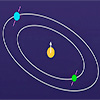 Scientists have long puzzled over why all of the planets in Earth's solar system have slightly slanted orbits around the sun. But a new, study suggests this phenomenon may not be so unusual after all. Even in 'pristine' solar systems, planets exhibit a bit of a tilt.
Scientists have long puzzled over why all of the planets in Earth's solar system have slightly slanted orbits around the sun. But a new, study suggests this phenomenon may not be so unusual after all. Even in 'pristine' solar systems, planets exhibit a bit of a tilt.
Nov 28th, 2023
Read more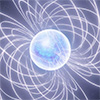 Scientists have studied a rare species of ultra-dense stars, so called magnetars, to uncover an underlying law that appears to apply universally to a range of objects known as neutron stars.
Scientists have studied a rare species of ultra-dense stars, so called magnetars, to uncover an underlying law that appears to apply universally to a range of objects known as neutron stars.
Nov 23rd, 2023
Read more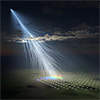 Scientists have successfully detected an ultra-high-energy cosmic ray with an energy level comparable to the most energetic cosmic ray ever observed. The cosmic ray is set to be named after the Japanese sun goddess, Amaterasu.
Scientists have successfully detected an ultra-high-energy cosmic ray with an energy level comparable to the most energetic cosmic ray ever observed. The cosmic ray is set to be named after the Japanese sun goddess, Amaterasu.
Nov 23rd, 2023
Read more